
The Seoul Metropolitan Subway is a metropolitan railway system consisting of 23 rapid transit, light metro, commuter rail and people mover lines located in northwest South Korea. The system serves most of the Seoul Metropolitan Area including the Incheon metropolis and satellite cities in Gyeonggi province. Some regional lines in the network stretch out beyond the Seoul Metropolitan Area to rural areas in northern Chungnam province and western Gangwon province, that lie over 100 km (62 mi) away from the capital.

Seoul Subway Line 2, also known as the Circle Line, is a circular line of the Seoul Metropolitan Subway. The line running clockwise is called the "inner circle line" and the counter-clockwise line is called the "outer circle line". This is Seoul's most heavily used line, and consists of the main loop, the Seongsu Branch and the Sinjeong Branch for a total line length of 60.2 km (37.4 mi). The Line 2 loop is the third longest subway loop in the world after Moscow Metro Bolshaya Koltsevaya line and Beijing Subway Line 10. In 2019, Line 2 had an annual ridership of 812 million passengers or 2.2 million passengers per day.

Apgujeong is a rapid transit station on Seoul Subway Line 3. It is located in Apgujeong-dong in the Gangnam-gu administrative district of Seoul. It has a pair of underground side platforms. The station has connections to 15 buses through 6 exits. It services Sinsa-dong and Apgujeong-dong. The area is named after a pavilion frequented by Han Myung-hoi, whose pen-name was Apgujeong, and its sub-name comes from the nearby flagship Apgujeong Main store of Hyundai Department Store.

Sinsa station is a station on the Seoul Subway Line 3 and the Shinbundang Line. It is located in Sinsa-dong, Gangnam-gu and Jamwon-dong, Seocho-gu, Seoul. It will serve as the northern terminus of the Wirye–Sinsa Line when it is opened in 2025.
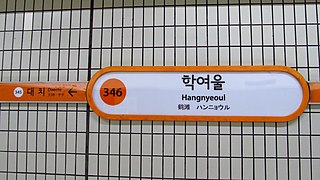
Hangnyeoul Station (Korean: 학여울역) is a station on the Seoul Subway Line 3 in Gangnam-gu, Seoul. The only exit of this station is connected to SETEC. This station has the least ridership of all Line 3 stations in Seoul.
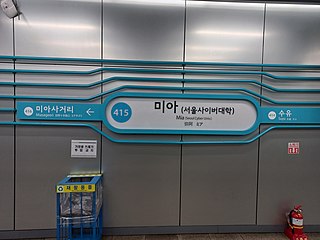
Mia Station is an underground station on the Seoul Subway Line 4. It is located in Mia-dong, Gangbuk-gu, Seoul, South Korea. Its station subname is Seoul Cyber Univ., where said university is nearby.

Gireum Station (Korean: 길음역) is an underground station of the Seoul Subway Line 4 in Gireum-dong, Seongbuk-gu, Seoul, South Korea. Jeongneung tomb lies nearby.

Suyu Station is an underground station on the Seoul Subway Line 4 in Suyu-dong, Gangbuk-gu, Seoul, South Korea.
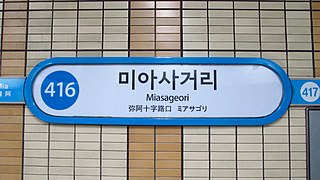
Miasageori Station is a station on the Seoul Subway Line 4. Its name means "four-way junction in Mia-dong." It is located in Mia-dong, Gangbuk-gu, Seoul. It was previously called Miasamgeori (미아삼거리), until December 26, 2013.
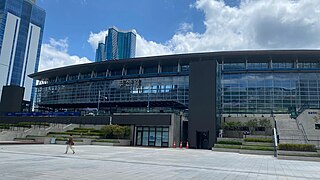
Busan station (Korean: 부산역) is a train station in Busan, South Korea. It is the southern terminus of the Gyeongbu Line & the Gyeongbu high-speed railway, the most important railway lines in the country, which links Busan with Seoul in around two and a half hours on KTX, Korea's high-speed rail train. There are also cheaper, slower rail alternatives to seoul, including the "Mugungwha" Train, which takes over four hours. Essentially all trains to Seoul stop in a few settlements between the two cities. It is also an underground station on Busan Metro Line 1 between Jungang and Choryang stations. The station is centrally located in the Choryang-dong (neighbourhood) of Dong-gu (ward) in Busan.

Yeongdeungpo District is an administrative district in southwest Seoul, South Korea. Although the origin of the name is uncertain, the first two syllables are thought to be from "yeongdeung" (靈登) or "divine ascent", a shamanic rite. The third syllable is "po", representing the bank of a river (浦), referring to the district's position on the Han River. The 2006 population was 408,819.

Myeong-dong Station is a station on the Seoul Subway Line 4. This station is located in Jung-gu, Seoul.

Ichon Station is a station in Yongsan-gu, Seoul on Seoul Subway Line 4 and the Gyeongui–Jungang Line. This station is the closest to the National Museum of Korea, situated in the interior of Yongsan Family Park. It also serves eastern Ichon-dong, home to the largest Japanese community in South Korea with some 1,300 Japanese residents.

Nowon station is a station on the Seoul Subway Line 4 and Line 7. The station on Line 4 is elevated whereas the station on Line 7 is underground, owing to the elevated tracks of Line 4 between Danggogae station and Chang-dong station. In addition, the two stations are far apart, making passengers walk a considerable distance for transfers.

Dongjak District (Dongjak-gu) is one of the 25 gu that make up the city of Seoul, South Korea. Its name was derived from the Dongjaegi Naruteo Ferry, on the Han River which borders the district to the north. It was the 17th gu created in Seoul, after being separated from Gwanak District on 1 April 1980.

Incheon Subway Line 2 is a driverless, medium-capacity subway line running 29.2 km (18.1 mi) from Oryu-dong in Seo-gu to Incheon Grand Park, with 27 stations, part of the Incheon Subway system. The line is also included as a part of the overall Seoul Metropolitan Subway network; Juan station has a free transfer with Seoul Subway Line 1, Geomam station connects with the AREX Line to Incheon International Airport and Seoul Station, and Seongnam also has a free transfer with Seoul Subway Line 7.
The Seoul City in South Korea plans to build up to ten new light metro, or light rapid transit (LRT). They would be connected to the Seoul Metropolitan Subway giving access to several hundred subway stations. As opposed to traditional subway lines, LRT lines have a lower capacity.
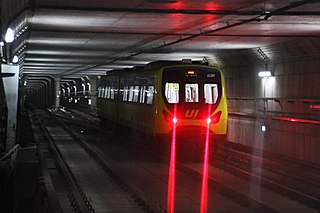
The Ui LRT, referred to as the Ui-Sinseol LRT or Ui-Sinseol Line (우이신설선) in Korean, is a light metro which is part of Seoul Metropolitan Subway. It is a fully underground 11.4 km (7.1 mi) Light Rapid Transit line from Ui-dong to Sinseol-dong in northern Seoul which opened on September 2, 2017. The line, which is expected to carry 110,000 passengers a day, has 13 stations. It connects to Line 4 at Sungshin Women's University, Line 6 at Bomun and Lines 1 & 2 at Sinseol-dong. The last (northernmost) station is in Ui-dong, hence the name of the line. In 2019, the line carried 27 million passengers or about 75,000 people per day.

Seoul Transportation Corporation, branded as Seoul Metro, is a municipal-owned corporation owned by Seoul Metropolitan Government, and one of the two major operators of Seoul Metropolitan Subway with Korail.
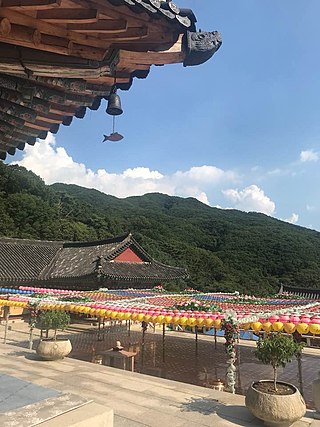
Cheonggyesa is a temple of the Jogye Order of Korean Buddhism in Uiwang, Cheonggyesan (Seoul/Gyeonggi). The temple was first built in Silla Kingdom era.





















